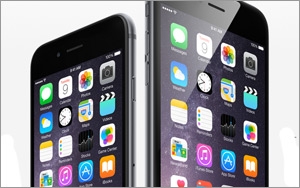 U.S. mobile phone sales by consumers earning less than $30,000 annually grew more than 50% for the third consecutive quarter ended February 2015 -- making this demographic the largest
segment of the smartphone market, accounting for 28% of all sales, per stats released Tuesday.
U.S. mobile phone sales by consumers earning less than $30,000 annually grew more than 50% for the third consecutive quarter ended February 2015 -- making this demographic the largest
segment of the smartphone market, accounting for 28% of all sales, per stats released Tuesday.
The NPD Group reports that Apple made the greatest impact with less affluent consumers,
accounting for 35% of sales for iPhone 6 and 6 Plus, and buyers earning more than $100,000 annually chose the newest iPhone more than two-thirds of the time.
Sales among consumers earning more
than $100K annually rose by 24%. Those ages 55+ became the fastest-growing age segment with the demographic taking 24% of all sales, compared with a year ago. The age group now represents 28% of all
sales.
advertisement
advertisement
The stats, released Tuesday, represent a change in the way individuals use technology to search for information. Tuesday is also the day that Google updates its mobile algorithms to
consider mobile-friendliness when returning search query results. This means that some sites
will serve up less often if they are not "correctly" optimized, per Google's standards.
The change is likely to have a much greater impact than the algorithm updates Panda and Penguin -- which
Google rolled out in 2011 and 2012, respectively.
One reason for Google's change is an increase in smartphone sales. For the three-month period ending February 2015, overall sales of mobile
phones rose 28% compared with the year-ago time period, per NPD Group. During that same time smartphone sales rose 35%, with non-smartphone sales declining to 14%.
Apple and Samsung accounted
for two of every three smartphones sold during the three-month period ended February 2015, while Apple sales rose 45% and Samsung by 10%, per NPD Group. iPhone 6 and iPhone 6 Plus represented
57% of Apple sales, down from iPhones 5s and 5c, which accounted for 63% of sales.
The iPhone 6 and iPhone 6 Plus were most popular among the older demographic, with 69% of sales to
consumers ages 55 and older, while 46% of purchases made by customers ages 18 to 34 went for the newest iPhone models.
This growth is not surprising, considering that U.S.
government-subsidized programs like Lifeline are spending about $2.2 billion in
2012 to give away phones and service.
comScore released numbers earlier this month estimating that 186.3 million people in the U.S. owned smartphones during the three months ending in
February 2015 -- up 5% since November. The Google Search app took 52.2% market share, per comScore. The stats also agree with NPD's ranking, suggesting Apple took the most smartphone market share with
41.7% of U.S. subscribers. Samsung ranked second with 28.6%, followed by LG with 8.3%, and Motorola with 5.1% .